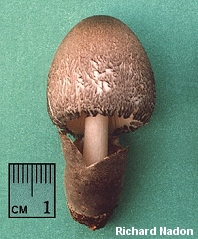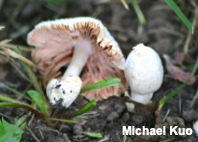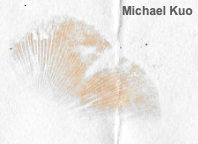Key to 20+ Volvariella and Volvopluteus Species in North America
| 1. | Growing on other mushrooms (species of Clitocybe). | Volvariella surrecta |
| 1. | Not growing on other mushrooms. | 2 |
| 2. | Growing directly from wood (stumps, logs, trees). | 3 |
| 2. | Growing terrestrially, or in compost or woodchips. | 9 |
| 3. | Mature cap less than 4 cm wide. | 4 |
| 3. | Mature cap 4 cm wide or wider. | 5 |
| 4. | Cap velvety, brownish black over the center with radial brownish black fibers elsewhere; margin not lined; stem light gray; recorded from Florida (by a more trustable source than the state's elections board). | Volvariella lepiotospora |
| 4. | Cap not velvety, gray to bluish gray with dark radial fibers; margin lined; stem white; recorded from North Carolina. (Imperfectly described species; type collection lost.) | "Volvariella cinerea" |
| 5. | Cap surface bald (not granular, silky, or hairy) and slimy; margin lined; recorded from New York. | Volvariella peckii |
| 5. | Cap surface granular, silky, or hairy, dry; margin lined or not; variously distributed. | 6 |
| 6. | Margin lined; cap surface "granular"; recorded from the Caribbean. | Volvariella jamaicensis |
| 6. | Margin not lined; cap surface silky or hairy; variously distributed. | 7 |
| 7. | Cap more highly colored. | 8 |
| 8. | Cap sooty to dark coffee-colored; recorded from Mexico, Cuba, and Puerto Rico. | Volvariella bakeri |
| 8. | Not as above. Various wood-loving Volvariellas with non-white caps may key out here. Whether or not these mushrooms represent undescribed species or mere color forms of Volvariella bombycina remains to be determined. | Volvariella spp.? |
| 9. | Mature cap medium sized to large—usually 5 cm wide or wider. | 10 |
| 9. | Mature cap small to medium-sized—usually under 5 cm. | 17 |
| 10. | Cap white or nearly so. | 11 |
| 10. | Cap more highly colored. | 12 |
| 11. | Stem with grooves; cap dry; recorded from Florida. | Volvariella canalipes |
| 11. | Stem without grooves; cap sticky to slimy when fresh; widely distributed. | |
| 12. | Cap drab to grayish, gray, or brownish—but not dark brown. | 13 |
| 13. | Cap sticky when fresh (ixocutis present). | 14 |
| 14. | Spores 10.5–13.5 µm long; known with certainty from a single collection, on sawdust in Michigan, but possibly often identified as Volvopluteus gloiocephalus. | Volvopluteus michiganensis |
| 14. | Spores 13–20 µm long; widely distributed in North America. | |
| 15. | Stem often with a "ring" (resulting from the collapsing of the volva); cap drab with brownish scales; spores 9–12 µm long; reported from Washington D.C. and possibly Michigan. (Imperfectly described species; type collection lost.) | "Volvariella avellanea" |
| 15. | Stem not as above; cap gray to brown, smooth to silky; spores 7–10.5 µm long; fairly common and "widely distributed" but typically reported from woodchips, greenhouses, botanical gardens, compost piles, and so on. | |
| 16. | Cap bald; odor not distinctive; spores 15–20 µm long; recorded from Alabama. | Volvariella alabamensis |
| 16. | Cap with dark radiating fibrils; odor at least sometimes strong and unpleasant; spores 6–8.5 µm long; recorded from Cuba and South America. | Volvariella cubensis |
| 17. | Volva white and conspicuously hairy; cap grayish, 2.5–3.5 cm across, finely hairy; spores 6–7 µm long; found east of the Rocky Mountains. | Volvariella villosavolva |
| 17. | Volva not conspicuously hairy, white to gray or brown; cap varying; spores varying; variously distributed. | 18 |
| 18. | At least the center area of cap white (the rest of the cap variously colored). | 19 |
| 18. | Center of cap not white. | 22 |
| 19. | Cap sticky when fresh, relatively bald; spores longer than 10 µm long; cheilocystidia primarily rostrate. | Volvopluteus earlei |
| 19. | Cap dry when fresh, appressed-fibrillose or finely hairy; spores 9 µm long or shorter; cheilocystidia not usually rostrate. | 20 |
| 20. | Cap 0.5–1.5 cm across when mature; recorded from Michigan. | Volvariella pellucida |
| 20. | Cap larger than above when mature; variously distributed. | 21 |
| 21. | Stem bald; cap margin lined at maturity; primarily found east of the Rocky Mountains. | |
| 21. | Stem fuzzy to hairy; cap margin not lined;widely distributed in North America. | |
| 22. | Cap gray to brown, evenly colored (not markedly darker over the center portion); margin not lined; found east of the Rocky Mountains. | |
| 22. | Cap grayish to brownish or whitish, with a notably darker center; margin lined or not; variously distributed. | 23 |
| 23. | Cap whitish overall with a pinkish center; margin not lined; recorded from the Pacific Northwest. | Volvariella smithii |
| 24. | Cap whitish overall with a black center; margin not lined; spores 7–8.5 µm long; recorded from Florida. | Volvariella alachuana |
| 24. | Cap grayish overall with a dark brown to blackish center; margin or nearly the entire cap lined or deeply grooved; spores 5–7 µm long; possibly widely distributed east of the Great Plains. | |
References
Boekhout, T. (1986). Notulae ad floram agaricinam Neerlandicam--XII: Small, saprophytic Volvariella species in the Netherlands. Persoonia 13: 197-211.
Boekhout, T. (1990). Volvariella. In Bas, C., Th. W. Kuyper, M. E. Noordeloos & E. C. Vellinga, eds. Flora Agaricina Neerlandica: Critical monographs on families of agarics and boleti occurring in the Netherlands. Volume 2. Rotterdam: A. A. Balkema, 56–64.
Boekhout, T. & M. Enderle (1996). Typification of Volvariella gloiocephala (DC.:Fr.) Boekhout & Enderle. Persoonia 16: 249–251.
Coker, W. C. (1947). North Carolina species of Volvaria. Journal of the Elisha Mitchell Scientific Society 63: 220–230.
Desjardin, D. E. & D. E. Hemmes (2001). Agaricales of the Hawaiian Islands—7. Notes on Volvariella, Mycena sect. Radiatae, Physalacria, Porpoloma and Stropharia. Harvard Papers in Botany 6: 85–103.
Justo, A. & M. L. Castro (2010). The genus Volvariella in Spain: V. dunensis comb. & stat. nov. and observations on V. earlei. Mycotaxon 112: 261-270.
Justo, A., A. M. Minnis, S. Ghignone, N. Menolli Jr., M. Capelari, O. Rodriguez, E. Malysheva, M. Contu & A. Vizzini (2011a). Species recognition in Pluteus and Volvopluteus (Pluteaceae, Agaricales): morphology, geography and phylogeny. Mycological Progress 10: 453–479.
Justo, A., A. Vizzini, A. M. Minnis, N. Menolli Jr., M. Capelari, O. Rodriguez, E. Malysheva, M. Contu, S. Ghignone & D. S. Hibbett (2011b). Phylogeny of the Pluteaceae (Agaricales, Basidiomycota): taxonomy and character evolution. Fungal Biology 115: 1–20.
Kosonen, L. Volvariella Speg. In Knudsen, H. & J. Vesterholt, eds. (2018). Funga Nordica: Agaricoid, boletoid, clavarioid, cyphelloid and gastroid genera. Copenhagen: Nordsvamp. 395–398.
Menolli Jr., N. & M. Capelari (2008). Records and two new species of Volvariella (Pluteaceae, Agaricales) from Brazil. Mycotaxon 106: 385–398.
Monoson, H. L., A. S. Methven & W. J. Sundberg (1993). Illinois species of Volvariella (Basidiomycetes, Agaricales, Pluteaceae). Mycotaxon 49: 269–278.
Sá, M. C. A. & F. Wartchow (2016). Volvariella leucocalix (Pluteaceae), a new species from Brazilian semiarid region. Mycosphere 7: 30-35.
Shaffer, R. L. (1957). Volvariella in North America. Mycologia 49: 545–579.
Shaffer, R. L. (1962). Synonyms, new combinations, and new species in Volvariella (Agaricales). Mycologia 54: 563–572.
Seok, S. J., Y. S. Kim, H. Y. Weon, K. H. Lee, K. M. Park, K. H. Min & K. H. Yoo (2002). Taxonomic study on Volvariella in Korea. Mycobiology 30: 183–192.
Vázquez, L. S., L. Guzmán-Dávalos & G. Guzmán (1989). Contribucion al conocimiento de las especies del genero Volvariella en Jalisco. Revista Mexicana de Micologia 5: 169–179.
Wartchow, F. (2009). Volvariella cubensis: a rare neotropical agaric new to South America. Mycotaxon 107: 181-187.
Weber, R. & Webster, J. (1996). Volvariella surrecta: An uncommon mycoparasite. Mycologist 10: 160.
This site contains no information about the edibility or toxicity of mushrooms.
Cite this page as:
Kuo, M. (2018, December). The genera Volvariella and Volvopluteus. Retrieved from the MushroomExpert.Com Web site: http://www.mushroomexpert.com/volvariella.html
© MushroomExpert.Com



